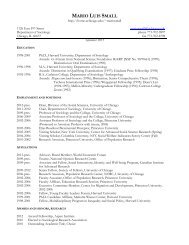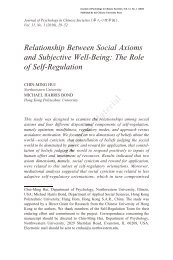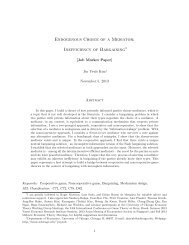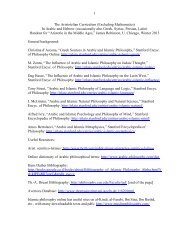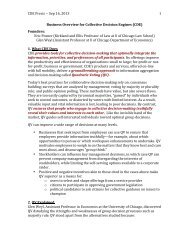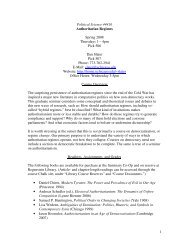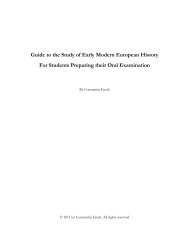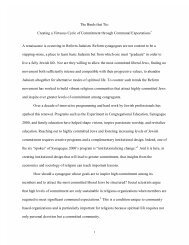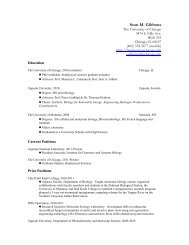Convergence Between Black Immigrants and Black Natives Across ...
Convergence Between Black Immigrants and Black Natives Across ...
Convergence Between Black Immigrants and Black Natives Across ...
Create successful ePaper yourself
Turn your PDF publications into a flip-book with our unique Google optimized e-Paper software.
1 Introduction<br />
The number of black immigrants living in the US has increased 13-fold from 1970 to 2010, increasing their<br />
share of the black population from 1% to 10%. Figure 1 illustrates how black immigration from the West<br />
Indies <strong>and</strong> Africa exploded over the last few decades. Note that black immigrants also have a higher fertility<br />
rate than native blacks, which will naturally increase the share of second generation blacks. 1<br />
In 2011, black immigrant men earned close to $10,000 or 40% more than black native men. This premium<br />
shrinks to $3,000 or 7% once we condition on being employed. The analysis of employment, education,<br />
incarceration, <strong>and</strong> marriage outcomes, confirms that we are dealing with two completely different<br />
subsets of the population. <strong>Black</strong> immigrant men are much more likely than native black men to be employed,<br />
married, <strong>and</strong> not incarcerated. Schooling patterns point towards much higher college completion percentages<br />
<strong>and</strong> less high school dropouts for black immigrant men. Similar analysis applies to women though the<br />
variation in outcomes is generally compressed. 2<br />
This paper intends to answer three questions. First, how different are first generation blacks from native<br />
blacks <strong>and</strong> what are the forces underlying these differences? Second, in how far are observable characteristics<br />
such as high education levels transmitted to the second generation? Third, in how far are less salient<br />
characteristics such as motivation <strong>and</strong> dedication transmitted to the second generation? In addition to across<br />
generation transmission, this paper will also explore within generation transmission. In other words, how do<br />
immigrants that enter the US when they are young differ from immigrants who enter the country when they<br />
are old, <strong>and</strong> why do they differ?<br />
Throughout this paper I focus on 21-65 year olds in order to capture the working age population. I will<br />
distinguish between three mutually exclusive groups: immigrants, individuals born in the US with immigrant<br />
parents, <strong>and</strong> others. I will refer to them as the first generation, second generation, <strong>and</strong> natives. An individual<br />
belongs to the second generation if one or both of the parents are born abroad. <strong>Black</strong>s will be compared<br />
to Hispanics, Asians, <strong>and</strong> whites, where blacks, Asians, <strong>and</strong> whites always refer to non-Hispanic blacks,<br />
Asians, <strong>and</strong> whites. 3<br />
This paper is organized as follows. Section 2 summarizes the previous literature. Section 3 presents<br />
descriptive statistics to highlight the differences between native <strong>and</strong> immigrant blacks as well as the first<br />
<strong>and</strong> second generation. Section 4 <strong>and</strong> 5 discuss the convergence with respect to earnings across <strong>and</strong> within<br />
generations, respectively. Section 6 extends the convergence analysis to labor force participation patterns.<br />
Section 7 introduces a theoretical model that helps explain both phenomena. Section 8 concludes.<br />
1 In 2011, a black immigrant female above the age of 16 had a 48% higher probability of having a child than a native black female.<br />
While black immigrant women have a larger total fertility rate compared to native black women, their teenage pregnancy rates are<br />
half as high. In 2011, 4.2% of black native teenage girls had a child, while only 2.2% of black immigrant teenage girls did (based on<br />
author’s calculations using ACS data).<br />
2 In previous work I show that excluding black first <strong>and</strong> second immigrants increases inequality measures such as the black-white<br />
wage, employment, college completion, <strong>and</strong> incarceration gap by amounts ranging from 5 to 25% (Rauh 2013).<br />
3 For simplicity, I will often refer to Hispanics as a racial group, despite the fact that they would more correctly be defined as an<br />
ethnic group.<br />
2



